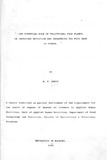| dc.description.abstract | A cross-sectional /descriptive study was undertaken in Mukono District, Uganda. The study was mainly to observe the use of traditional food plants relative to the use of exotic food plants.
Questionnaires were used to establish the familiarity of the community with the traditional food plants. Elders' knowledge of the traditional food plants was obtained using a rapid assessment procedure (R.A.P) using focus group discussion.
Proximate chemical composition of the traditional vegetables was determined, as well as selected nutrients and the antinurient- oxalate, content.
Results of the study indicate that there is considerable change in the use/popularity of traditional food plants grown or collected in the past to some different food plants which are now widely adopted as traditional food plants for the community under study. Although there is a decrease in the use/popularity of the traditional food plants, the study does not indicate much increase in the use/popularity of the exotic food plants.
Chemical composition of the vegetables indicate that local vegetables, particularly the neglected ones, are high in the nutrients determined when compared with some exotic vegetables such as cabbages, lettuce etc. for which values were extracted from various food composition Tables. Ascorbic acid levels of twelve of t.he fourteen analyzed traditional vegetables fell within the range of 33.3 - 677.4 mg/lOOg on a dry matter basis. Beta-carotene levels of all the analyzed traditional vegetables fell within the range of 8300 - 242300ug/100g on a dry matter basis, while iron and calcium levels ranged from 4.4 - 15.5 mg/lOOg and 770 - 2480 mg/lOOg on a dry matter basis respectively. The levels of the anti-nutrient oxalate in the analyzed vegetables ranged from 10.8 - 93.3 mg/lOOg on a dry matter basis. These levels are lower than the reported 176- 15,766mg/i00g levels on a dry mattfer basis of similar vegetables. | en_US |



